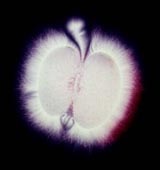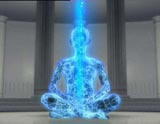Integral Health
The metaphysical basis for Integral Health — beyond the sense-experience
The first radical step in spiritual and mystical experience was the transcendence of sense-experience. This did not mean a belittling of sensory functioning and a glorification of sensory impoverishment. Sensory perception is our first gateway to knowledge and this was duly acknow-ledged. In Sanskrit, the term Indriya is used to denote the sensory apparatus and the Vedic god Indra shares the same linguistic root. It is the function of Indra to oversee that the quest for knowledge is not distorted or misled by the senses.
The fact that sensory perception is our first and basic gateway to knowledge does not mean that it represents the Truth or is error-free. The first knowledge of the universe which we get in the form of the sun moving around the earth is not a fundamental truth but a phenomenal truth. Therefore, a second gateway to knowledge had to be worked out in the form of a clear, discerning rational intellect which could put the right values to the sensory inputs. Spiritual and mystical experience thus pursued the quest for suprasensible truths. The first prerogative was to accept the fact that if the senses could perceive gross material reality, the supra-sensible would have its domain in usually imperceptible ‘subtle matter’ as well as in ‘non-material’ reality.
Subtle matter
Sri Aurobindo writes that “Even in the world of Matter there are existences of which the physical senses are incapable of taking cognisance (1).” Science acknowledges this and augments the biological limits of our sensory perception with high precision instruments like the microscope. However, using a technology of consciousness, it is possible to perceive subtle workings of the material reality. One such spectacular feat was the unraveling of all the 92 naturally occurring elements down to the ‘quark’ and even ‘sub-quark’ level through sensory dissection of occult nature by two Theosophists, Annie Besant and C.W. Leadbeater, years before scientists understood them, albeit with more precision than the best supercollider accelerator could do (2). This venture was started in 1895 (a full description of the phenomenon by Dr. Mahadeva Srinivasan appeared in The Hindu Magazine in 1994 and was reprinted in NAMAH). The Mother and Sri Aurobindo have dwelt extensively on ‘subtle’ matter in the human sphere. Sri Aurobindo has explained the workings of the subtle body-consciousness which can be activated to function independent of the mental will or even against the mental will (3). It is this subtle matter in the human body that has to be worked upon to construct the template of the new, future body that has been envisaged as a milestone in the evolution of consciousness which Sri Aurobindo maps in The Life Divine. It is difficult for the materialistic mindset to appreciate the subtlety of matter as it has studied the physical reality by de-linking the consciousness perspective. Integral Health attempts to restore the balance by placing the material body within the matrix of consciousness.
An understanding of the functioning of subtle matter needs the development of subtle senses. Once developed, the subtle senses can also be used to tap subtle non-material realities.
Subtle senses
Sri Aurobindo describes, “Not only are there physical realities which are suprasensible, but, if evidence and experience are at all a test of truth, there are also senses which are supraphysical and can not only take cognisance of the realities of the material world without the aid of the corporeal sense-organs, but can bring us into contact with other realities, supraphysical and belonging to another world — included, that is to say, in an organisation of conscious experiences that are dependent on some other principle than the gross Matter of which our suns and earths seem to be made(4).” These supraphysical, ‘subtle’ senses are located in an ‘inner’ or ‘subtle’ or ‘subliminal’ being that stands behind the ‘outer being’. The ‘outer being’ is studied as ‘personality’ in the academic discipline of psychology, the ‘inner being’ is known to spiritual traditions.
It is due to the ‘subtle senses’ that during meditation, one can hear mantras, church-bells or have visions of gods, fairies or angels (we are here referring to integrative experiences and not psychotic states). In ‘Out of Body experiences’ (OBE), subjects have often reported of ‘visualising’ one’s own surgery or ‘hearing’ conversations at a distance when actually they were under anaesthesia. It seems that the subtle senses can get activated during such states. In fact, parapsychology deals with subtle senses which yogīs and mystics have always experientially perceived. Sri Aurobindo points out, “The increasing evidences, of which only the most obvious and outward are established under the name of telepathy with its cognate phenomena, cannot long be resisted except by minds shut up in the brilliant shell of the past, by intellects limited in spite of their acuteness through the limitation of their field of experience and inquiry, or by those who confuse enlightenment and reason with the faithful repetition of the formulas left to us from a bygone century and the jealous conservation of dead or dying intellectual dogmas (5).” Of course, he simultaneously warns that the testimony of the subtle senses “has to be controlled, scrutinised and arranged by the reason, rightly translated and rightly related, and their field, laws and processes determined (6).”
Non-material realities
The spiritual tradition also discovered that there were ranges of consciousness that could not be grasped either by our sensory apparatus or rational intellect and necessitated the development of supra-sensorial and supra-rational faculties like ‘intuition’ and ‘revelation’. In fact, much of our ‘material’ research could be initiated by such supra-rational faculties. The microscope was a material invention but the scientific mind had an intuitive idea that there was something which needed instrumentation for visualisation. The intuitive idea that preceded and determined the scientific endeavour to visualise outwardly imperceptible things is of primary importance. It was through intuition that many secrets of science and medicine were unravelled by seers long before the advent of modern science.
Supra-sensorial and supra-rational faculties like intuition have always been available to humanity in flashes and glimpses but too scattered in time and space to be integrated into a coherent science. Sri Aurobindo takes up that task in The Life Divine to organise the supra-sensorial and supra-rational faculties in a systematised and graded way so that there is a logical extension from the realm of ‘Mind’ to the realm of ‘Supermind’. This provides the gestalt of an emergent consciousness-based yoga psychology that provides the metaphysical foundation for a futuristic vision of Integral Health.
This long adventure in consciousness was initiated when spirituality acknowledged the necessity for transcendence of the sense- experience. Otherwise we would have been lost in a hedonistic culture and denied the joy of a divine life.
References:
1. Sri Aurobindo. SABCL, Volume 18. Pondicherry; Sri Aurobindo Ashram Trust, 1970, p. 18.
2. Srinivasan, M. The Amazing phenomenon of extra-sensory perception of nuclear structure and sub-atomic particles. NAMAH 2000; 7:2: 18-29.
3. Op. cit. SABCL, Volume 22. Pondicherry; Sri Aurobindo Ashram Trust, 1970, p.350.
4. Op. cit. SABCL, Volume 18. Pondicherry; Sri Aurobindo Ashram Trust, 1970, p. 18.
5. Ibid.
6. Ibid, p. 19.
Share with us (Comments, contributions, opinions)
When reproducing this feature, please credit NAMAH, and give the byline. Please send us cuttings.


